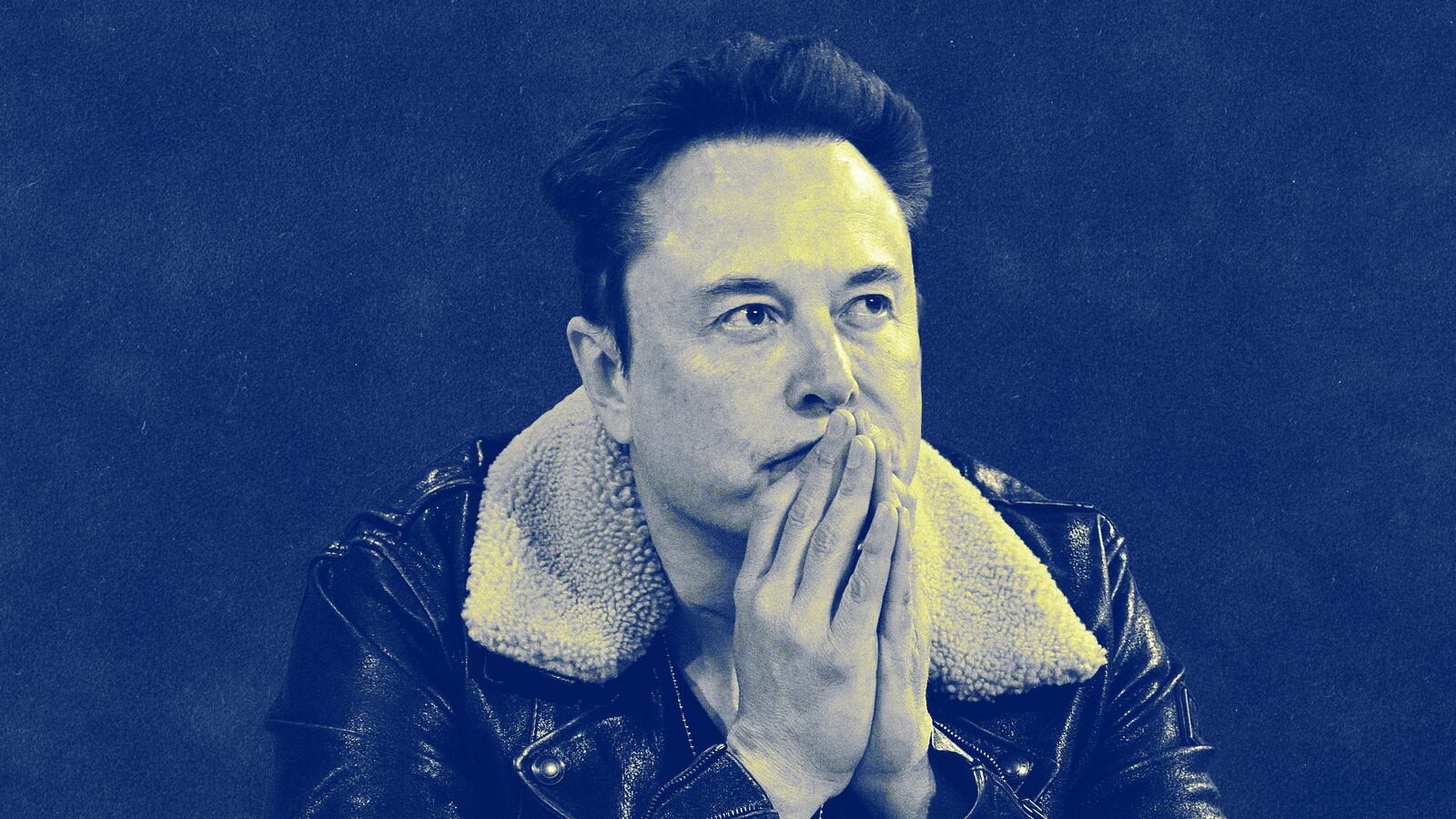Elon Musk’s Twitter takeover may have dominated the news cycle for months, but as Zoe Schiffer’s new book Extremely Hardcore proves, there’s still a lot more to learn.
Schiffer, a veteran tech journalist who worked as a senior reporter at The Verge before becoming managing editor at Platformer, meticulously details the chaos before and after Musk’s much-covered coup, surfacing new details of the takeover.
The book starts with Musk’s very first tweet—“This is actually me,” he wrote, after being impersonated by another user—and runs all the way through the Oct. 7 attack on Israel, misinformation about which ran rampant on the platform. Along the way, it details Musk’s stealth Twitter stock purchases, his failed attempt to get out of his purchase agreement, the botched rollout of Twitter Blue, and much more. The book is based on interviews with more than 60 employees and “hundreds of pages of internal memos, whistleblower complaints, and court documents,” according to Schiffer’s foreword.
Here are some of the more scintillating details in the 300-page romp through Elon Musk’s “extremely hardcore” version of Twitter—or, as it is now known, X.
Jack Dorsey tried to get Elon Musk on the board of Twitter
By 2020, Dorsey, the scraggly-bearded Twitter founder, was growing increasingly distant from the social media behemoth he created, and employees were growing tired of the slow pace of change he cultivated at the site. In an attempt to turn the site around, Schiffer reports, he tried to install Musk on the board of directors—a move the existing board rejected as too risky. Dorsey lamented this decision, calling it “completely stupid and backwards” and later saying that was around the time he decided to leave the company for good. Dorsey stepped down in November 2021 and remained largely silent about Musk’s purchase, though he did offer up his 2.4 percent equity stake in the company toward the financing—a detail previously reported in Walter Isaacson’s biography of the billionaire.

Jack Dorsey
Joe Raedle/GettyTwitter gave Musk a special handle
Schiffer expands on an anecdote she previously tweeted about, revealing how Musk received favors from the Twitter team even before his takeover. In the spring of 2022, after stealthily buying up stock for months, Musk revealed he had become Twitter's biggest shareholder. Nervous about a potential takeover, the Twitter team tried to play nice. Around that time, Yoel Roth, then the head of Twitter's Trust and Safety Department, got a message from Chief Marketing Officer Leslie Bertland telling him to transfer the handle “@e” to Musk. According to Schiffer, highly coveted handles—such as a single letter—were usually released only when there was a “legitimate business association between the name and a particular user.” Roth and his staff could find no such connection to Musk, but they transferred it anyway. Musk changed the username to “John Utah” but never sent a single tweet from the account.
Musk bombed his first meeting with Twitter employees
In June 2022, in the midst of Musk’s acquisition of the company, he sat down for a virtual town hall with the people who would soon become his employees. According to Schiffer’s account, he tanked. Despite getting softball questions from Bertrand—”Why do you love Twitter?” and “How can Twitter employees earn your trust?”—he churned out vague, rambling, occasionally nonsensical answers. Explaining what he called his “unifying philosophy,” he told employees: “Civilization will come to an end at some point, but let’s try to make it last as long as possible. And it would be great to understand the nature of the universe.”
“This is someone who is either quite stupid or hasn’t given this much thought,” a former engineer told Schiffer of their first impression. “But either way he is not taking this seriously.”
The layoff process was a total mess…
Musk came into Twitter promising to slash costs and make the famously low-earning company profitable again. First on his list was a major round of layoffs, which The Washington Post reported could be up to 75 percent. According to Schiffer, that process was even more chaotic than previously reported. In the first days of Musk’s tenure, as managers huddled with their staff to try and reassure them, the company banned large meetings. (“Group meetings are no longer a thing,” the managers in charge of the layoffs reportedly said. “If you do that, you risk getting fired.”)
The layoffs were originally based on a list that a member of the finance team helped prepare for former CEO Parag Agrawal, when he anticipated letting 16 percent of the company go earlier that year. But the finance team member quickly learned Musk had a much deeper cut in mind. One day, she and the other staff in charge of layoffs directed managers to write a sentence for every person they wanted to keep on their team overnight; those who didn’t have a sentence by the next morning would be automatically cut. “It was like Schindler’s List,” one executive recalled.
By the end of the massacre, the company had cut 90 percent of its team in India, one of its most important markets; half of the infrastructure team; almost all of the developer platform staff; and about 75 percent of the team in charge of FTC compliance, Schiffer reports. Hundreds of contract workers were also cut, including one who reportedly had their Slack access cut off in the middle of making changes to the company’s child safety workflow. The cuts were so drastic that the company was forced to re-hire some laid-off employees in order to finish certain projects. Managers compiled notes about who should be re-hired in a document called, simply, “fires.”
…and so was the Twitter Blue rollout
Anyone on Twitter in November 2022 witnessed the absolute chaos that was the rollout of Twitter Blue, the Musk-inspired subscription service that doled out blue “verified” badges only to paying members. Comedians and trolls leapt on the opportunity, changing their display names to impersonate major world figures, including Musk. In an especially effective example cited by Schiffer, a user changed his display name and profile picture to mimic that of Eli Lilly, one of the country’s biggest producers of insulin, then tweeted: “We are excited to announce insulin is free now.” It took six hours for Twitter to take down the post, during which time the company’s stock dropped 4.37 percent. Less than 48 hours after the launch, Twitter was forced to pause all Blue registrations, “in order to address impersonation issues,” according to a staff update Schiffer obtained.
Musk made engineers boost his tweets
This anecdote was previously reported by Schiffer and the team at Platformer, but it’s so wild it bears repeating. Three and a half months into his time at the helm of Twitter, Musk reportedly had a conniption fit about one of his tweets performing worse than President Joe Biden’s. The billionaire was so upset by this—and by a recent decline in his engagement on the app—that his cousin, James Musk, summoned some 80 Twitter engineers at 2:30 a.m. to devise a solution to their boss’s low engagement. (“Everything else you are focusing on is great,” James told one engineer around that time, “but there is nothing else on Elon’s mind but the engagement issue.”)

Musk was very worried about his personal engagement on the platform.
Chris Delmas / AFP via GettyThe resulting, late-night fix put Musk in every Twitter user’s feed—regardless of whether they followed him—and boosted his tweets “by a factor of one thousand,” according to the book. “It’s just like that meme of that girl pouring milk down her friend’s throat,” an excited Musk reportedly gushed to employees, shortly before tweeting out the very same meme. “That’s like me with the tweets.” Not everyone was so satisfied: One high-level programmer lost his job for suggesting that Musk’s lack of engagement was simply the result of declining interest in the billionaire.
Reinstating Trump’s account was easier said than done
Musk promised to make Twitter a bastion of free speech, in part by restoring accounts banned under previous leadership. That included former President Donald Trump, who was removed from the platform following his endorsement of the Jan. 6 siege of the Capitol. In November 2022, Musk asked his followers whether Trump’s account should be reinstated, and responded to the slight majority “yes” vote by tweeting: “Vox populi, vox Dei.”
But reinstating the former president's account wasn't as easy as firing off a tweet. According to Schiffer, doing so required processing millions of pieces of data, and the newly shrunken staff didn’t have the bodies to pull it off. The team exchanged urgent messages just minutes before Trump’s account was set to go live, at one point realizing that the “follow” button on his profile didn’t work and that every refresh turned up a different number of followers. Musk himself offered to jump in and help, via a message from head of trust and safety Ella Irwin.

Donald Trump opted for Truth Social over Twitter.
David Becker/GettyThe engineers eventually got Trump’s profile up in running, but it was all for naught: The former president announced days later he would be focusing on his own social media network, Truth Social, and would not be returning to Twitter.
‘Twitter Files’ led to threats against pregnant employee
In December 2022, Musk gleefully celebrated the release of the “Twitter Files”—a collection of internal Twitter documents concerning the platform’s handling of the Hunter Biden laptop story, which Musk claimed would reveal a liberal bias that permeated the highest echelons of the company before his rule. The documents’ release caused a splash in the conservative press, but had unintended consequences.
The company failed to redact the name of a low-level employee only tangentially involved in the response to the laptop story. That employee—a pregnant woman living in Australia—received a torrent of racist messages and death threats after the documents were published, including tweets linking to the location of her husband’s family. According to Schiffer, it took more than 24 hours for the trust and security team to respond to the employee’s request for help. She wound up taking a month-long mental health leave from work—then, after Musk reduced the company’s parental leave, left altogether.
Musk was paranoid about press leaks
As negative stories about Musk’s leadership permeated the news cycle, he grew paranoid about leaks from inside. In December 2022, he sent an email to Twitter employees stating that anyone who violated the NDA they signed upon hiring would “accept liability to the full extent of the law,” adding that Twitter would “immediately seek damages.” (This email, of course, was promptly leaked to Schiffer.) Following another leak to Schiffer, the company temporarily shut down internal Slack messages, claiming the app was down for maintenance. In fact, they were looking for leakers.
According to Schiffer, the company came down on the wrong guy. In February 2023, it fired an engineer named Randall Lin after claiming to have proof that he leaked information about the infamous Super Bowl tweet incident to Schiffer. To this day, Lin maintains that he was not the leaker. After his firing, however, he became a prominent source for Schiffer’s book.







